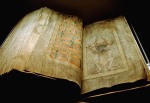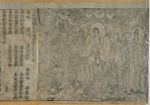Welcome to another Top Ten Tuesday post! This week’s theme from That Artsy Reader Girl is a Thanksgiving theme, and while we don’t celebrate Thanksgiving in Australia, I’ve decided to enter into the spirit of things today by spotlighting some people (or groups) whom book lovers everywhere can be thankful for.
The Phoenicians – The Alphabet
 The Phoenicians are credited with creating the first alphabet (a set of symbols representing the phonemes of a spoken language). There are sporadic examples of similar alphabet systems prior to this, but the Phoenician alphabet is the first widely-used, complete alphabet known to us today. And while I don’t have any experience with other alphabet systems, I’m pretty fond of this one and the worlds that open up through the words the letters can make.
The Phoenicians are credited with creating the first alphabet (a set of symbols representing the phonemes of a spoken language). There are sporadic examples of similar alphabet systems prior to this, but the Phoenician alphabet is the first widely-used, complete alphabet known to us today. And while I don’t have any experience with other alphabet systems, I’m pretty fond of this one and the worlds that open up through the words the letters can make.
Cai Lun (A.D.48-121) – Paper

Cai Lun was a Chinese inventor and politician and is credited with being the inventor of paper as we know it today (as opposed to papyrus) and the papermaking process. From there, it was several hundred years before this papermaking process was brought to the Islamic world, and then another few hundred years before it arrived in Europe in the 11th Century.
Cai Lun’s papermaking process differed from papyrus in that the material was thoroughly soaked and broken down before being pressed into paper. This not only resulted in a smoother surface but also produced something with less tendency to break apart over time and use, which papyrus was prone to do.
The Romans – The Codex

In the ancient world, the most common form of recording the written word was the scroll or the clay tablet, both of which had their limitations and neither of which I would particularly like to be reading novels on today! Sometime around the 1st Century A.D., a new way of collating the written word began to be more widely used: stacking pieces of papyrus or parchment on top of one another and binding them down one edge. Revolutionary! Particularly as it meant you could access the information it contained at random rather than sequentially as with a scroll. This new format was called a codex, and it was the beginning of the book as we know it today. If you’re interested in more details about the development of the codex, then this BBC article is a great place to start.
The Chinese – Woodblock Printing

Book lovers actually have much to thank the Chinese for. Not only was Cai Lun a pioneer of papermaking, but the printing process was pioneered by the Chinese as well. (Codices were handwritten.) Woodblock printing was first used by the Chinese as early as A.D.220 (and probably earlier) as a method of printing on textiles, but later was also used to print on paper. The oldest known printed book is the Diamond Sutra, dated 11 May A.D.868. Woodblock printing was a lengthy process of printing, as you can imagine, as the image (or text) had to be carved into a wooden face, but this began to change when another Chinese man, Bi Sheng, invented the first movable-type technology.
Johannes Gutenberg (1400-1468) – The Printing Press

Johannes Gutenberg was a German blacksmith and goldsmith who took what the Chinese had already developed, improved it, and introduced it to Europe. Among the improvements he made were the invention of a process to mass-produce movable type using metals (the Chinese used wood and then porcelain) and the use of a wooden press which improved the process for transferring ink to paper. The cumulative effect of his improvements was to make the printing of books quicker and therefore more economically viable and affordable. Thank you Johannes Gutenberg!
Aldus Manutius (c.1449-1515)

Aldus Pius Manutius was an innovative publisher at a time when publishing was really taking off thanks to Gutenberg’s press. Not only did he publish and disseminate rare texts, but he did so in their original Greek or Latin where applicable. He commissioned typefaces specifically for those languages which became the precursor of our modern italic type. But most importantly, he developed a new form of small, portable books called Enchiridon (small manual or handbook). These books revolutionised personal reading and are considered by many to be the precursor of the modern paperback.
Christopher Latham Sholes (1819-1890) – The Typewriter

It’s not fair to give Christopher Latham Sholes all the credit for the development of the typewriter—he stood on the shoulders of several who went before him, including Italians Agostino Fantoni and Pellegrino Turri, both of whom invented a type of typewriter in the first decade of the 1800s in order to help a blind relative or friend. However Sholes created the first typewriter that was commercially successful, and many of its features were still standard in typewriters produced a century later. His second model was patented in 1868, and five years later, after many improvements, he signed a contract with E. Remington and Sons for manufacture. Incidentally, Mark Twain was the first author to submit a typed manuscript for publication.
Michael Faraday (1791-1867) – Electrical Generation

As with the typewriter, many people are responsible for the development in our understanding and use of electricity. I guess you could say many hands make light work. 😂 However, I mention Michael Faraday because his work on the generation of electricity was foundational in making electricity available for use in technology. I’m sure you don’t need any help to imagine all the ways in which this has helped bring books to us! And while we’re at it, let’s also be thankful for Nikola Tesla, who developed the alternating-current electrical system still used across the world today.
Thomas Edison (1847-1931)

Thomas Edison is another man who stood on the shoulders of those who went before him. Warren de La Rue came up with a light bulb forty years before Edison, but the materials used made it uneconomical. In 1878, just a year before Edison’s light bulb, Joseph Swann demonstrated a more commercially viable model, however his material didn’t have the longevity needed. When Edison came up with a solution that was both economically and practically viable, he thus was credited with giving us the light bulb. And avid readers have been losing sleep ever since!
Sir Allen Lane (1902-1970)
Last on my list for today is the man who brought high-quality paperbacks to the mass-market: Sir Allen Lane, who founded Penguin Books in 1935 with his brothers Richard and John Lane. Cheap, paperback reading material had been available for around a century or so in the form of serials like the infamous “penny dreadfuls” of the 19th Century and the pulp fiction of the 20th Century, but these stories were typically sensational fiction and poor quality. Allen Lane wanted to make quality fiction available at the same affordable price, and it was the purchase by Woolworths Group of enough books to pay for the project outright that set it on the path to success and made other publishers sit up and take notice. So next time you pick up your favourite paperback, thank Sir Allen Lane.



This is an excellent post! I had so much fun going through this and learning new facts. 😀
What a wonderful idea for this week’s prompt. I learned a few things about the history of the written word today. Thank you.